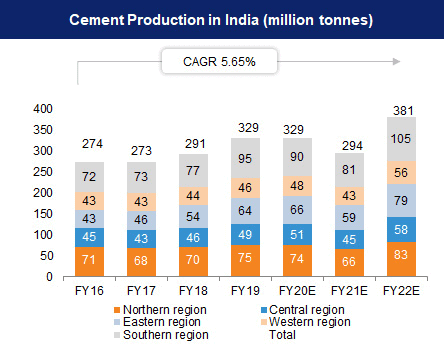
Introduction
India, being the world’s second-largest cement producer after China, contributes over 8% to the global installed capacity. The country’s potential for development in infrastructure and construction is vast, and the cement sector is poised to benefit significantly from this growth.
The infrastructure industry, which includes utilities, bridges, dams, roads, and metropolitan facilities, plays a pivotal role in India’s economic growth. It not only facilitates the expansion of various industries like real estate and construction but also aids in the production of cement.
Let’s see the case study on the cement industry.
You may also like: From print to digital: The story of India’s media and entertainment sector
Cement industry – An overview
Cement is like the secret sauce in construction and engineering projects. It is what makes concrete, which is the most popular construction material in the world.
India’s cement industry is like the backbone of a bunch of other sectors. Think infrastructure, construction, housing, transportation, coal, power, steel – you name it!
It’s also a big player in implementing various government schemes like housing for everyone, concrete highways, smart cities, ultra-mega power projects, the Clean India mission, waterways, and more.
In 2023, the cement industry in India was massive, hitting 396.7 million tons. It might reach a staggering 599.7 million tons by 2032.
The demand for cement in India is on the rise, showing a compounded annual growth of 5.65% from 2016 to 2022. Thanks to the country’s abundant and high-quality limestone deposits, the cement industry in India has massive growth potential.

As of August 2023, India is home to 210 large cement plants, with 77 located in Rajasthan, Andhra Pradesh, and Tamil Nadu.
Here is the bifurcation of India’s cement production capacity based on region:
- 33% in South India,
- 22% in North India,
- 13% in West India,
- 13% in Central India, and the remaining
- 19% in East India
Crisil Ratings reports that India’s cement industry is poised for a substantial capacity expansion of approximately 80 million tonnes by FY24. This marks the largest growth in a decade, driven by heightened spending on housing and infrastructure developments.
History of the cement industry in India
Cement and concrete, as we know them today, have a pretty epic backstory. It is a tale that goes back over 5000 years, from the time of the Egyptian pyramids to the sleek, modern architecture we see today.
India jumped into the cement-making game in 1914 with the setting up of a company in Porbandar, Gujarat – the Indian Cement Company Limited. After that, more and more factories were established. However, they didn’t see the competition coming – cheaper imports of cement started giving them a run for their money.
But, today, India is second only to China in cement production capacity. Over the last decade, the cement industry in India has expanded greatly, making the country a net exporter to the world.
Also Read: The role of the energy sector in powering India’s growth.
Government initiatives
Today, India stands as the world’s second-largest cement producer for various reasons, one of which is government initiatives.
Here are some recent actions taken by the government:
- In the budget 2023-24, the central government sanctioned a whopping ₹ 2.7 lakh crore for the Ministry of Road Transport and Highways. This is likely to make the demand for cement go up.
- In October 2021, the Prime Minister initiated the ‘PM Gati Shakti – National Master Plan’ aimed at establishing a seamless, world-class multimodal transport network across India. This initiative might significantly stimulate future cement demand.
- Apart from this, under the ‘housing for all’ segment, the budget estimate for Pradhan Mantri Awas Yojana in 2023-24 is a massive ₹79,590 crore.
Risks and challenges
Despite numerous opportunities available for the cement industry, these opportunities are posed with some risks:
- India’s cement industry grapples with challenges such as increased input costs and logistical issues, which may impact profitability.
- High transportation costs and inefficiencies due to poor infrastructure and port delays also add to the expenses.
- Regulatory hurdles, including lengthy approval processes for new and expanding plants, also cause delays.
- Finally, the industry, being a major contributor to air pollution and CO2 emissions, needs to invest in technology upgrades to meet emission standards and energy efficiency norms.
- The Ministry of Railways’ plan to create dedicated corridors for the cement sector is promising, but the benefits are yet to be seen.
Also Read: Understanding the basics of the broking industry and its recent trends
Top companies in the cement industry
Below is a list of the top 5 cement companies in India, ranked by market capitalisation (as of December 11, 2023):
| Name of the Company | Market cap (₹ cr) | Net profit (₹ cr) |
| UltraTechCement | 279,186.00 | 5,069 |
| Shree Cements | 102,117.90 | 1,269 |
| Ambuja Cements | 100,076.52 | 2,996 |
| Dalmia Bharat | 43,997.74 | 529 |
| ACC | 40,922.60 | 869 |
Road ahead
Finally, the Indian government’s commitment to infrastructure development and smart city initiatives, coupled with plans to enhance railway capacity and storage facilities, is set to stimulate construction activity and cement demand.
The cement industry’s robust growth prospects, driven by the need for local production, could attract significant foreign investment, aligning with India’s ‘Make in India’ initiative.
The future of India’s cement industry looks promising, fueled by strong demand from the infrastructure and housing sectors. As the concrete evidence of progress hardens, the cement industry stands as a pillar of India’s booming economy.

